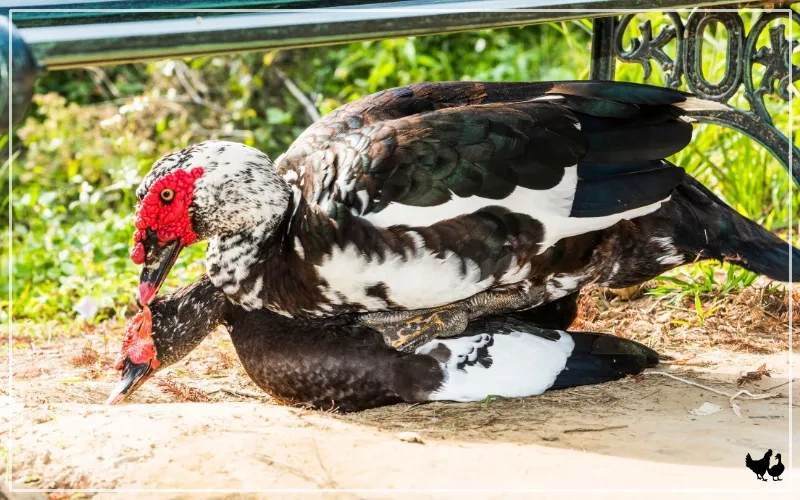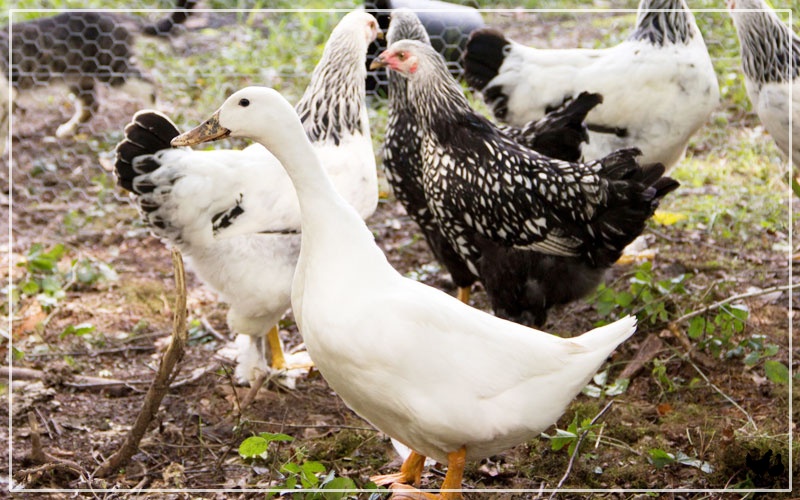How to Tell if Muscovy Duck is Male or Female?
If it’s your first time raising Muscovy ducks, you may have trouble telling the male and female ducks apart.

Luckily, sexual dimorphism is present in this duck breed, making it relatively easy to tell if a Muscovy duck is male or female.
Identifying the gender is easy when these birds are adults, but what if they’re still ducklings? Sexing Muscovy ducklings can be a bit difficult, but nowhere near impossible.
Below, I will cover the differences between females and males of the species and highlight some of the differences that are present even in Muscovy ducklings, so you can have a better idea which duckling is male, and which is female.
Male vs Female Muscovy Duck – What is the Difference?
When looking at adult Muscovy ducks, it’s easy to tell the genders of each. Here are some of the most important differences between a male and female Muscovy duck:
– Body Size
Body size can be a reliable indicator in adult Muscovy ducks. That’s because drakes are often twice the size of a duck. Males also have more prominent breasts, a longer body, a longer and slightly bigger head.
But these differences are only relevant when you’re seeing adult ducks of the same age side-by-side.
Body size becomes a less reliable indicator of gender when you’re examining Muscovy ducks of various ages, because the size difference can be chalked up to the fact that the ducks you’re examining are at different stages of development.
While body size can help determine the gender of adult Muscovy ducks of the same age, there’s another aspect of body size that can also help reveal the gender of a duck, namely the growth rate.
– Growth Rate
In ducklings, identifying the sex based on body size is not a reliable indicator, but growth rate can give you a good idea about the gender of the duckling.
That’s because at around 5 to 8 weeks old, male Muscovy ducklings will start outgrowing female ducklings.
Female ducklings will have a smooth chest, smaller body length, and smaller feet compared to the male ducklings.
But growth rate is still not the most reliable indicator, especially if you have ducklings of various ages, at various stages of development.
But because the differences between the genders don’t stop here, let’s see what other traits distinguish female Muscovy ducks from drakes.
– Feet Size
Differences in foot size can be observed even while Muscovies are still ducklings. Even without body size differences becoming visible, male ducklings will have disproportionately larger feet compared to their body.
Not only will their feet become larger; they will also be thicker. Females, on the other hand, have feet that are more proportionally sized and much slender compared to that of the males.
These differences can become noticeable as early as 4 to 7 weeks of age. That said, it’s not a guarantee that these differences will be very noticeable, however, in adulthood, they can be used to identify the gender of a duck.
Ideally, however, you should not rely on feet size alone to make a positive identification. To reliably sex a Muscovy duck, you will need to take into account other elements too.
Feet size, growth rate and size differences are not the only aspects that can help you tell female and male Muscovy ducks apart.
– Bill Shape
Another physical trait that can help you tell the gender of a Muscovy duck is the bill shape. This isn’t a very reliable method to sex a duck and should be used together with other methods.
So how is the bill shape different in female and male ducks? Even as early as 3 weeks old, the beak starts to take on a different shape in the case of male ducks.
Muscovy drakes will have a flatter and straighter bill that looks wider than a female’s, whose bill will be narrower, pointier, and less straight, with a ridge running down the middle.
For what it’s worth, these differences are subtle, and may pose a problem for the uninitiated. Even so, they can help in the identification of the sex, when viewed together with other methods.
– Feathers
A reliable method of sexing Muscovy ducks is feather growth. The feathers on a female duckling will start growing earlier and much faster.
This difference shows up as early as 4 weeks old, allowing you to clearly distinguish between male and female ducklings. The feathers will start appearing at the wings, but also the tail and belly.
So, if some of your ducklings start growing feathers while others are not, the ones that do are likely females.
– Behavior
Besides the many physical characteristics that help in deciding which duck is the female and which is the male, behavior is another thing to keep in mind.
Behavior is not a very reliable method to determine the sex – especially if you’re not familiar with how ducks normally behave.
But observe them enough, and you might pick up on the fine behavioral details that make one gender different from the other.
One of the behavioral cues that’s noticeable in male ducklings is that they may appear lazier than other ducklings.
That’s because of their accelerated growth rate compared to that of females, which may cause pain or a bit of weakness in their feet.
Another behavioral trait that can give away male ducklings is their propensity to being nippier than females. Male ducklings will be more inclined to nibble fingers or clothes than female ducklings.
A third behavioral cue is stance – males usually have a wider stance than females, while females can often be observed to often step on their own feet.
But neither of these behavioral traits is enough to positively identify the gender of a duckling or duck. However, taken together with other traits and behavioral cues, they can be of some help.
– Tail Shape
To identify the sex of a duck based on the shape of the tail, both ducks must be almost fully feathered, and even then, the difference will not always be as clear cut as you’d imagine.
Observed from above, the tail feathers of the drake are wider, almost U-shaped. Those of the female duck are V-shaped and narrower.
The reason why it’s not always easy to notice this difference is that female ducks may fan their tail out for various reasons, at which point the tail will no longer look narrow.
In ducklings, tail shape is not a difference you should rely on to identify the gender. Instead, you can rely on the other methods I described so far, which can give you a better idea if you’re looking at a male or female Muscovy duck.
– Caruncles
Another physical trait that can be used to tell adult female and male Muscovy ducks apart is the caruncles. These are skin growth around the eye and base of the beak.
The texture of the caruncles is rough and wart-like, but it’s more pronounced in the case of males than that of females.
Male ducks will start growing their caruncles much earlier than females. While male Muscovies will start growing them at 16 weeks, females will only start growing them at 20 weeks.
Drakes will have a larger area of the face covered with caruncles and also have a knob at the base of the bill, which is absent in females.
The caruncles on the female duck are not only smaller but also smoother.
Caruncles can be used as a reliable way to identify the sex of Muscovy ducks, but since they only grow in adulthood, they cannot be used to identify the sex of ducklings.
– Vocalization
As ducklings, males may appear chattier than female ducks, but that changes when they transition into adulthood – male ducks will start losing their voice at around 12-16 weeks old and develop a hiss or huff.
This is a very reliable way to tell the difference between a male and female Muscovy duck.
Even if you don’t know what they should sound like, after observing them for a little while, you’ll notice how some ducks will hiss, while others will have more of a duck-like voice. The ones hissing and huffing are the males.

Vent Sexing Muscovy Ducks
I’ve chosen to discuss vent sexing in a separate section because it’s somewhat a double-edged sword.
On the one hand, if you’re already a pro, vent sexing is an extremely reliable method. If you’re a beginner, however, the risk of injuring the duckling is too high, so I don’t recommend you rely on this method.
What does vent sexing involve?
Vent sexing can be performed even on day-old ducklings, and it involves using your finger to invert the cloaca or vent revealing the sex organs of the duckling.
Because the act of inverting the vent can hurt the duckling if you don’t know what you’re doing, I advise you to try the other methods first, before resorting to vent sexing.
If you do want to become knowledgeable in vent sexing Muscovy ducks, first ask the help of a professional to walk you through the process, and only then try it yourself.
At What Age Can You Sex Muscovy Ducklings?
Vent sexing can be performed even on day-old Muscovy ducklings, while the other methods can be used to identify the sex as early as 3-4 weeks, depending on your skill level, and the method you use.
Don’t worry if you still have a lot of doubts and “maybes” at first, with time, you will have an eye for picking up even the subtlest differences and you will become better at telling the difference between Muscovy females and males.
Conclusion
Knowing how to tell male and female ducks apart can be important for a variety of reasons – having the right female-to-male ratio in your backyard, excluding drakes if you want to raise only female ducks, choosing a pair, etc. Also, female ducks are usually more expensive than males.
Apart from vent sexing, checking caruncles, body size, and vocalization, neither of the other methods are 100% reliable and should be interpreted together with other identifying factors for positive identification of the gender.
Spend enough time with and around Muscovy ducks, and you’ll become an expert in telling them apart. And a small tip that can always help you when in doubt – female Muscovy ducks are always more beautiful than males!



